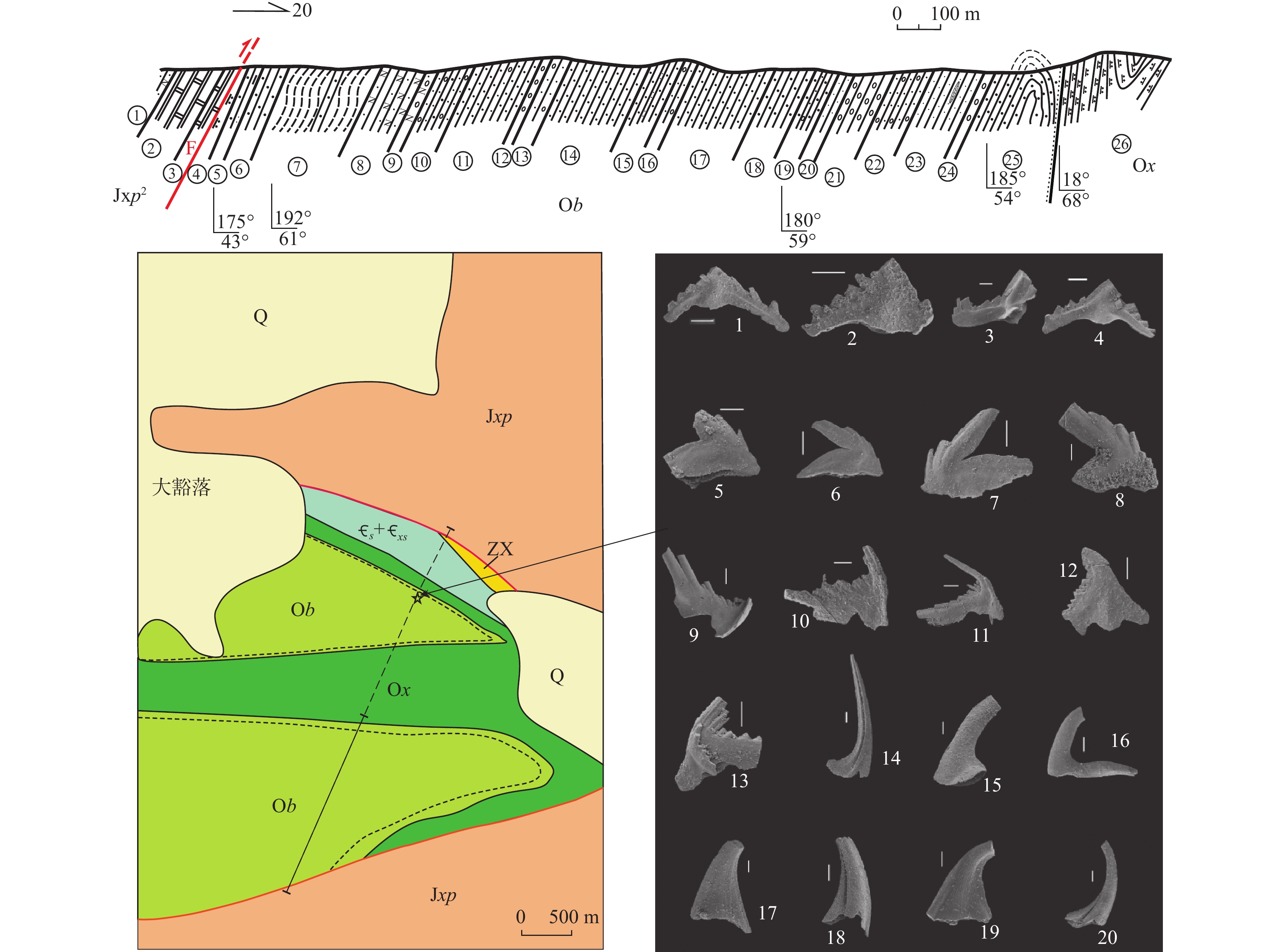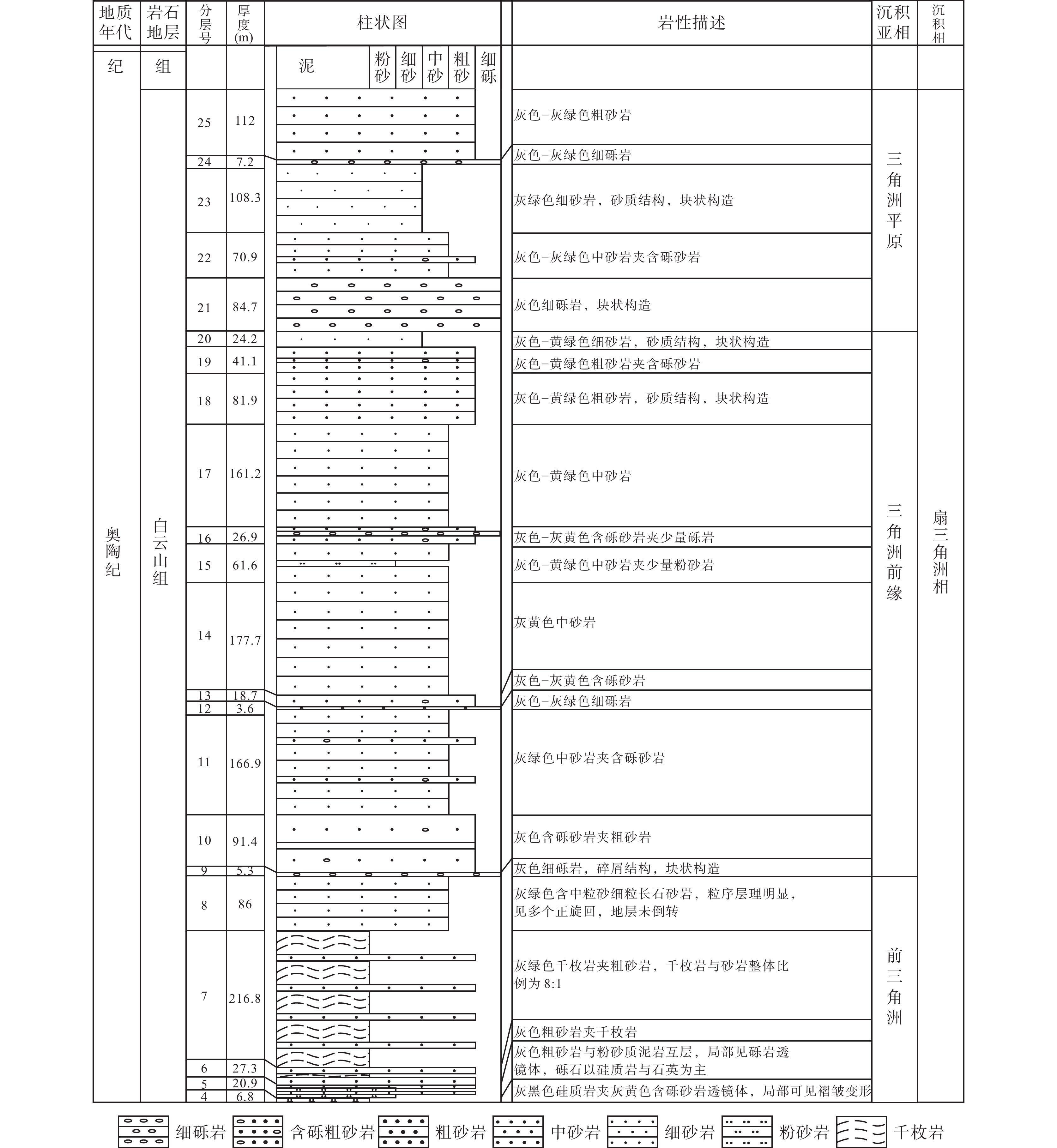The Discovery of Conodont Fossils in Dahuoluo Area in Ganau and the Related Date Determination for Baiyunshan Formation
-
摘要:
甘肃北山大豁落地区出露的白云山组是一套板岩、砂岩、砂砾岩、砾岩,局部夹灰岩的一套碎屑岩组合,由于缺乏地层学依据而被划归奥陶纪锡林柯博组(硅质岩为主,夹灰岩、砂岩、砂砾岩组合的一套浅海相沉积)。通过野外路线地质调查和剖面实测,在白云山组灰岩夹层中获得了保存较好的牙形刺化石,分别为大围刺Periodon grandis、原潘德尔刺(未定种)Protopanderodus sp.、镰箭(未定种)Drepanoistodus sp.、刺形刺(未定种)Spinodus sp.、小剑刺(未定种)Scabbardella sp.,将该套岩石组合时代限定为晚奥陶世。综合岩石组合特征、沉积层序与沉积相分析,认为白云山组形成于山前前陆盆地环境,预示着在晚奥陶世北山地区已进入初始造山阶段,为完善北山地层格架提供重要依据。
Abstract:The Baiyunshan Formation exposed in the Dahuoluo area of Beishan, Gansu Province is a set of clastic rock assemblages of slate, sandstone, glutenite, conglomerate, and locally intercalated limestone. Due to the lack of stratigraphic basis, it is classified as the Ordovician Xilinkebo Formation (a set of shallow marine sediments dominated by siliceous rocks, intercalated with limestone, sandstone and glutenite). Through field route geological survey and profile measurement, well-preserved conodont fossils have been obtained in the limestone interlayer of the Baiyunshan Formation. They are Periodon grandis, Protopanderodus sp., Drepanoistodus sp., Spinodus sp., Scabbardella sp., and the age of the rock assemblage is limited to the Late Ordovician. Based on the analysis of rock assemblage characteristics, sedimentary sequence and sedimentary facies, it is considered that the Baiyunshan Formation was formed in the piedmont foreland basin environment, indicating that the Beishan area has entered the initial orogenic stage in the Late Ordovician, which provides an important basis for improving the stratigraphic framework of Beishan.
-

-
奥陶系锡林柯博组(O1-2x) 26.黑色薄层状硅质岩 224.2 m =================== 平行不整合 =================== 奥陶纪白云山组(O3b) 25.灰色−灰绿色粗砂岩,砂质结构,碎屑以岩屑、石英、长石为主,分选、磨圆较好 112 m 24.灰色−灰绿色细砾岩,砾石分选中等,磨圆较好,局部见粒序层理 7.2 m 23.灰绿色细砂岩夹褐黄色泥质灰岩,砂质结构,分选、磨圆较好,局部见水平纹层 108.3 m 22.灰色−灰绿色中砂岩夹含砾砂岩 70.9 m 21.灰色细砾岩,砾石分选中等-差,次圆状,砾石粒径为0.3~0.7 cm 84.7 m 20.灰色−黄绿色细砂岩,局部见小型交错层理 24.2 m 19.灰色−黄绿色粗砂岩夹含砾砂岩,局部见交错层理与粒序层理 41.1 m 18.灰色−黄绿色粗砂岩,局部见水平层理与小型交错层理 81.9 m 17.灰色−黄绿色中砂岩,局部见小型交错层理与粒序层理 161.2 m 16.灰色−灰黄色含砾砂岩夹少量砾岩 26.9 m 15.灰色−黄绿色中砂岩夹少量粉砂岩 61.6 m 14.灰黄色中砂岩,局部见小型交错层理 177.7 m 13.灰色−灰黄色含砾砂岩,局部见小型交错层理与粒序层理 18.7 m 12.灰色−灰绿色细砾岩,砾石分选、磨圆中等 3.6 m 11.灰绿色中砂岩夹含砾砂岩,砾石成分以硅质岩与砂岩为主,局部具定向性 166.9 m 10.灰色含砾砂岩夹粗砂岩,砾石分选、磨圆较好 91.4 m 9.灰色细砾岩,碎屑结构,块状构造,砾石局部可见一定的定向性 5.3 m 8.灰绿色含中粒砂细粒长石砂岩,粒序层理明显,见多个正旋回,地层未倒转 86 m 7.灰绿色千枚岩夹粗砂岩,千枚岩与砂岩整体比例为8∶1 215.3 m 6.灰色粗砂岩夹千枚岩 27.3 m 5.灰色粗砂岩与粉砂质泥岩互层,局部见砾岩透镜体,砾石以硅质岩与石英为主 20.9 m 4.灰黑色硅质岩夹灰黄色含砾砂岩透镜体,局部可见褶皱变形 6.8 m =================== 断层 =================== 蓟县纪平头山组(JXp2) 3.灰色−深灰色含白云石大理岩,夹多条硅质条带与不连续硅质结核 34 m 2灰色片理化含白云石大理岩 127.4 m 1.灰色含含粗砂中细粒长石砂岩 10.7 m -
[1] 甘肃省地质局地质力学区测队. 1∶20万五道明幅区域地质报告[R]. 1977.
[2] 甘肃省地质局地质力学区测队. 1∶20万六驼山幅区域地质报告[R]. 1979.
[3] 甘肃省地质局地质力学区测队. 1∶20万嘎顺淖尔幅区域地质报告[R]. 1981.
[4] 甘肃省地质局第二区测队. 1∶20万石板井幅区域地质报告[R]. 1972.
[5] 甘肃省地质矿产局, 甘肃省岩石地层[M]. 中国地质大学出版社, 1997
[6] 甘肃省地质调查院. 1∶25万马鬃山幅区域地质调查报告[R] . 2000.
[7] 甘肃省革命委员会地质局区测二队. 1∶20万方山口幅区域地质报告[R]. 1973.
[8] 马智, 田毅, 龚全胜, 甘肃北山奥陶纪白云山组的沉积层序及地质意义[J], 甘肃科技, 2005, 21(9): 82-83
MA Zhi, TIAN Yi, GONG Quansheng, Sedimentary sequence and geological significance of Ordovician Baiyunshan Formation in Beishan, Gansu [J], Gansu Science and Technology, 2005, 21(9): 82-83.
[9] 内蒙古自治区地质矿产局. 内蒙古自治区岩石地层[M]. 武汉: 中国地质大学出版社, 1996.
[10] 王成源. 牙形刺生物古地理[A]. 石宝珩, 编. 中国地质科学新探索[M]. 北京: 石油工业出版社, 1998.
[11] 王成源. 牙形刺[M]. 北京: 科学出版社, 1987
[12] 王盛栋. 甘肃北山中部地区古生代洋板块地层重建与构造演化[D]. 武汉: 中国地质大学, 2017
WANG Shengdong. Reconstruction of Paleozoic Ocean Plate Stratigraphy in the middle Beishan Area Gansu Province[D]. Wuhan: China University of Geosciences, 2017.
[13] 王志浩, 祁玉平, 吴荣昌, 中国寒武纪和奥陶纪牙形刺[M]. 合肥: 中国科学技术大学出版社, 2011
WANG Zhihao, QI Yuping, WU Rongchang, Cambrian and Ordovician conodonts in China[M]. Hefei: China University of Science and Technology Press, 2011.
[14] 薛春玲, 戴霜, 陈中阳, 等. 亚洲奥陶系牙形刺生物地层研究进展[J], 地球科学进展, 2021, 36(1): 29-44
XUE Chunling, DAI Shuang, CHEN Zhongyang, et al. Research progress of ordovician conodont biostratigraphy in Asia[J]. Advances in Earth Science, 2021, 36(1): 29-44. (in Chinese with English abstract)
[15] 纵瑞文, 王仔章, 龚一鸣, 等. 西准噶尔伊尼萨拉蛇绿混杂岩中奥陶纪放射虫的发现及意义[J]. 中国科学: 地球科学. 2014, 44(10): 2238-2246
ZONG Ruiwen, WANG Zizhang, GONG Yiming, et al. Ordovician radiolarians from the Yinisala ophiolitic melange and their significance in western Junggar, NW China. Science China: Earth Sciences, 2014, 44 (10): 2238-2246.
[16] Aitchison J C, Flood P G, Malpas J. Lowermost Ordovician (basal Tremadoc) radiolarians from the Little Port Complex, western Newfoundland[J]. Geologica Magazine, 1998, 135(3): 413−419.
[17] Buckman S, Aitchison J C. Middle Ordovician radiolarians from West Junggar, Xinjiang, China[J]. Micropaleontology, 2001, 47(4): 359−367.
[18] Gradstein F, Ogg J, Smith A. A geologic time scale 2004 [M]. Cambridge: Cambridge University Press, 2004.
-




 下载:
下载:


